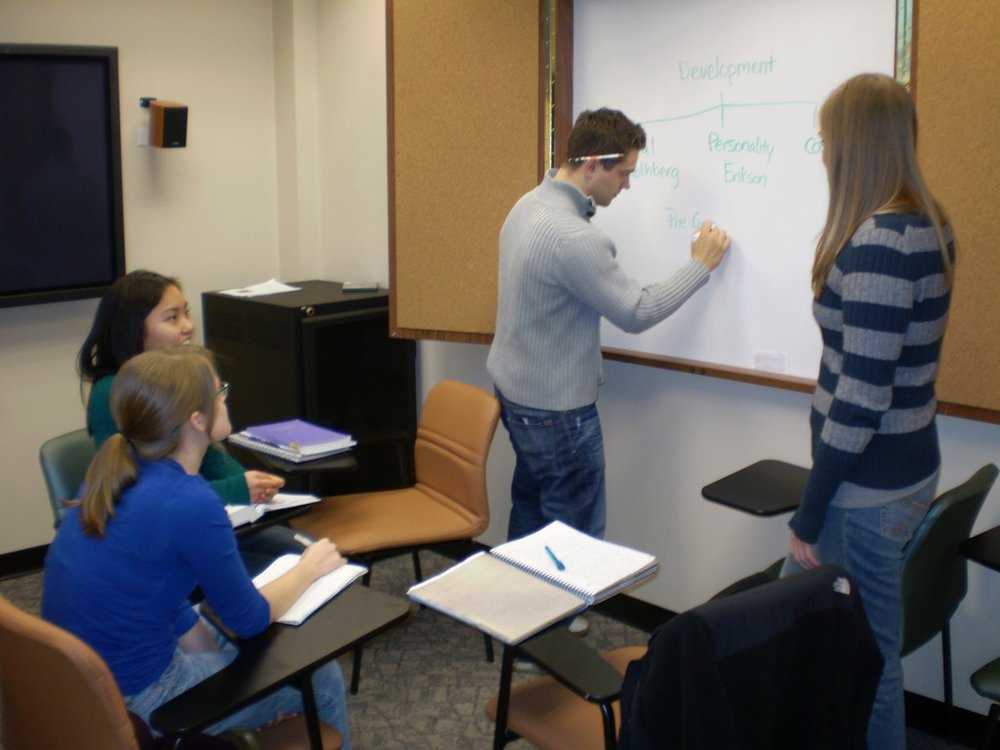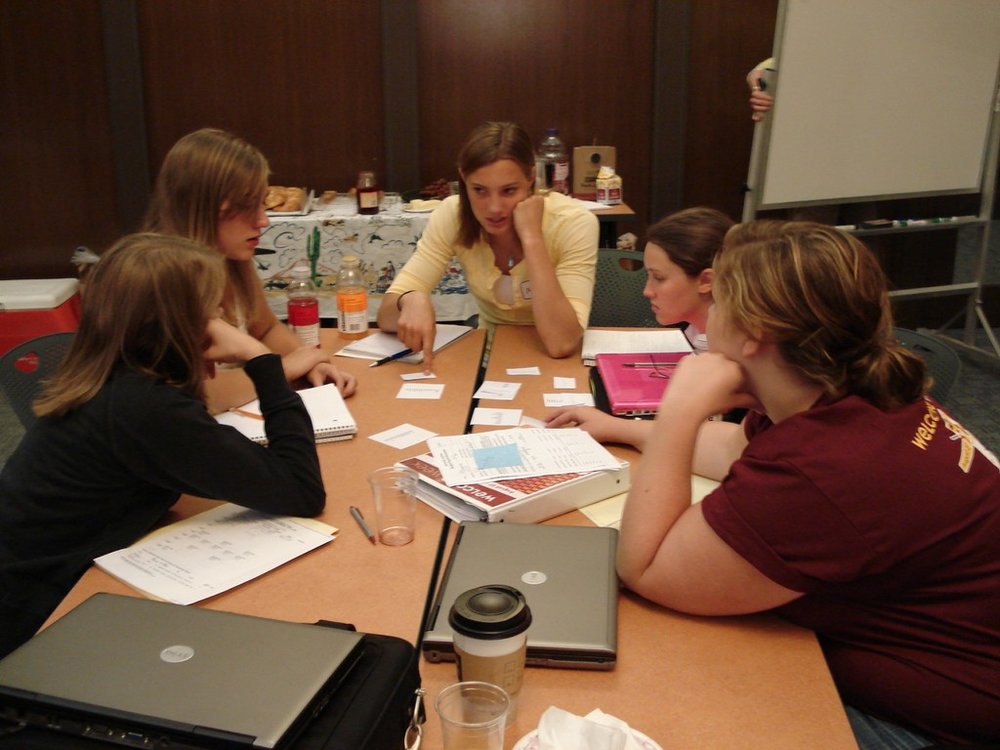
This blog focuses on my scholarship in my five research projects: learning assistance and equity programs, student peer study group programs, learning technologies, Universal Design for Learning, and history simulations. And occasional observations about life.
Assessing the impact of a muilti-disciplinary Peer Led-Team Learning program on undergraduate STEM education

There has been a national call to transition away from the traditional, passive, lecture-based model of STEM education towards one that facilitates learning through active engagement and problem solving. This mixedmethods research study examines the impact of a supplemental Peer-Led Team Learning (PLTL) program on knowledge and skill acquisition for students in introductory biology, chemistry, calculus and applied statistics courses. Results indicate program participants reliably outperform their matched pairs in courses that emphasize quantitative reasoning. Moreover, program participants report acquiring important insights about learning, collaboration, and engagement in undergraduate STEM education. These results are consistent with previous findings on PLTL and also provide insight into the roles of course context and student population on program outcomes.
To download the complete annotated bibliography of more than 1,100 citations of postsecondary peer cooperative learning programs, click on the following link, http://z.umn.edu/peerbib
Monitoring and evaluation of peer academic support programs in South African higher education institutions

The high failure and retention rates at universities despite peer academic support programs has necessitated the need for the present study to investigate how monitoring and evaluation is carried out to support the facilitators of these programs. The study adopted a qualitative approach, collecting data from a sample of 12 participants made up of program coordinators and peer academic facilitators. The results indicate that there is monitoring and evaluation of these programs by program coordinators and peer facilitators. This is achieved through observation during sessions, unannounced visits and support to facilitators. However, the structures and mechanisms of monitoring and evaluation are not strong enough to enhance effective implementation of the programs. It is concluded that although there are good peer academic support programs at this university under study, there is need for rigorous monitoring and evaluation as well as support by more qualified person.
To download the complete annotated bibliographny of more than 1,100 citations of postsecondary peer cooperative learning programs, click on the following link, http://z.umn.edu/peerbib
Research on group learning and cognitive science: A study of motivation, knowledge, and self-regulation in a larger lecture college Algebra class

At a research University near the east coast, researchers restructured a College Algebra course by formatting the course into two large lectures a week, an active recitation size laboratory class once a week, and an extra day devoted to active group work called Supplemental Practice (SP). SP was added as an extra day of class where the SP leader has students work in groups on a worksheet of examples and problems, based off of worked-example research, that were covered in the previous week’s class material. Two sections of the course were randomly chosen to be the experimental group and the other section was the control group. The experimental group was given the SP worksheets and the control group was given a questionand-answer session. The experimental group's performance was statistically significant compared to the control on a variety of components in the course, particularly when prior knowledge was factored into the data.
To download the complete annotated bibliography of more than 1,100 citations of postsecondary peer cooperative learning programs, click on the following link, http://z.umn.edu/peerbib
Exploring the emotional intelligence of student leaders in the SI context
 James, C., & Templeman, E. (2015). Exploring the emotional intelligence of student leaders in the SI context. Journal of the First-Year Experience & Students in Transition, 27(2), 67-81. Retrieved from http://www.ingentaconnect.com/contentone/fyesit/fyesit/2015/00000027/00000002/art00004?crawler=true
James, C., & Templeman, E. (2015). Exploring the emotional intelligence of student leaders in the SI context. Journal of the First-Year Experience & Students in Transition, 27(2), 67-81. Retrieved from http://www.ingentaconnect.com/contentone/fyesit/fyesit/2015/00000027/00000002/art00004?crawler=true
An exploratory study of the emotional intelligence (EI) of student leaders participating in a Supplemental Instruction (SI) program was conducted to determine whether a significant relationship exists between leadership effectiveness and EI as measured by the Bar-On Emotional Quotient Inventory (EQ-i) and to assess the impact of the leadership experience on EI scores through pre- and post-testing. The results revealed a statistically significant difference in the Total EQ-i of the more effective leaders as compared to the others. The more effective leaders also scored higher on all the EQ-i subscales, with the differences on Social Responsibility, Impulse Control, and Reality Testing being statistically significant. As for changes in EI, only the scores on the EQ-i Problem Solving subscale increased significantly between the pre- to post-testing sessions. Implications for practice and future research are addressed.
To download the complete annotated bibliography of more than 1,100 citations of postsecondary peer cooperative learning programs, click on the following link, http://z.umn.edu/peerbib
Peer-assisted learning program: A creative and effective learning approach at higher education

The primary purpose of this article is to review the effect of Peer-Assisted Learning (PAL) program on higher education. Thus, this paper tries to explain the educational theories and concepts which support the effectiveness of the program. It also to identify the benefits and shortcomings of the program to the students who participated in the program based on the existing researches and experiences of some universities which had undertaken the schemes. The review is expected to highlight the best practices of PAL program adopted by universities. Lastly, recommendations from previous researches for a successful implementation of PAL were taken that to be used in the implementation of the program in the university, particularly for the accounting faculty.
To download the complete annotated bibliography of more than 1,100 references with postsecondary peer cooperative learning programs, click on the following link, http://z.umn.edu/peerbib
Students helping students: Evaluating a pilot program of peer teaching for an undergraduate course in human anatomy.

The educational literature generally suggests that Supplemental Instruction (SI) is effective in improving academic performance in traditionally difficult courses. A pilot program of peer teaching based on the SI model was implemented for an undergraduate course in human anatomy. Students in the course were stratified into three groups based on the number of peer teaching sessions they attended: nonattendees (0 sessions), infrequently attended (1-3 sessions), and frequently attended (_ 4 sessions). After controlling for academic preparedness [i.e., admission grade point average (AGPA)] using an analysis of covariance, the final grades of frequent attendees were significantly higher than those of nonattendees (P50.025) and infrequent attendees (P50.015). A multiple regression analysis was performed to estimate the relative independent contribution of several variables in predicting the final grade. The results suggest that frequent attendance (b50.245,P50.007) and AGPA (b50.555, P<0.001) were significant positive predictors, while being a first-year student (b520.217, P50.006) was a significant negative predictor. Collectively, these results suggest that attending a certain number of sessions may be required to gain a noticeable benefit from the program, and that first-year students (particularly those with a lower level of academic preparedness) would likely stand to benefit from maximally using the program. End-of-semester surveys and reports indicate that the program had several additional benefits, both to the students taking the course and to the students who served as program leaders.
To download the complete annotated bibliography of more than 1,100 citations of postsecondary peer cooperative learning programs, click on the following link, http://z.umn.edu/peerbib
The impact of Supplemental Instruction on the performance of male and female engineers in a freshmen chemistry course.

This study used statistical analysis to examine correlations between first year engineering students’ use of SI and their performance in a required general chemistry course at Northeastern University. Overall we found that students who used SI were more motivated in General Chemistry than their counterparts. We also draw the following specific conclusions from our data: Students who were more confident that they would receive a high grade in General Chemistry at the beginning of the course had a higher average grade threshold for seeking SI. Students who sought SI exhibited a positive correlation between grade threshold for seeking help outside the classroom and final grade received. Females who used SI had significantly higher grades than females who did not. SI in the form of Chem Central, the Connections Chemistry Review, and the COE Tutoring Office were all found to have the potential to have a significant positive impact on students’ grades. Students who did not use SI were significantly more likely to skip lecture than students who do attend SI. Increased absenteeism in lecture was associated with lower final grades in both fall 2013 and fall 2014. Females were more likely to attend lecture regularly than males. When extra credit incentives were offered to attend lecture, both genders skipped significantly fewer lectures and received significantly higher grades. We believe the results we have found regarding relationships between students’ use of SI and their success in General Chemistry for Engineers can be applied to improve SI across the freshman engineering curriculum. For example, as Chem Central, the Connections Chemistry Review, and the COE tutoring office were all found to have a positive impact on students’ grades, resources like these could be created to help freshman students in their other courses. Further study of possible interaction effects among these and other variables for which we have data are ongoing. Our results also show that the students who often skip lecture are the students who do not take advantage of resources for SI and receive lower course grades. These may be students who need additional advising and mentoring during their freshman year in order to succeed. The issues raised are important topics of focus for future work in order to gain a further understanding of the impact of SI on freshman engineering students.
To download the annotated bibliography of more than 1,100 citations of postsecondary peer cooperative learning programs, click the following link, http://z.umn.edu/peerbib
